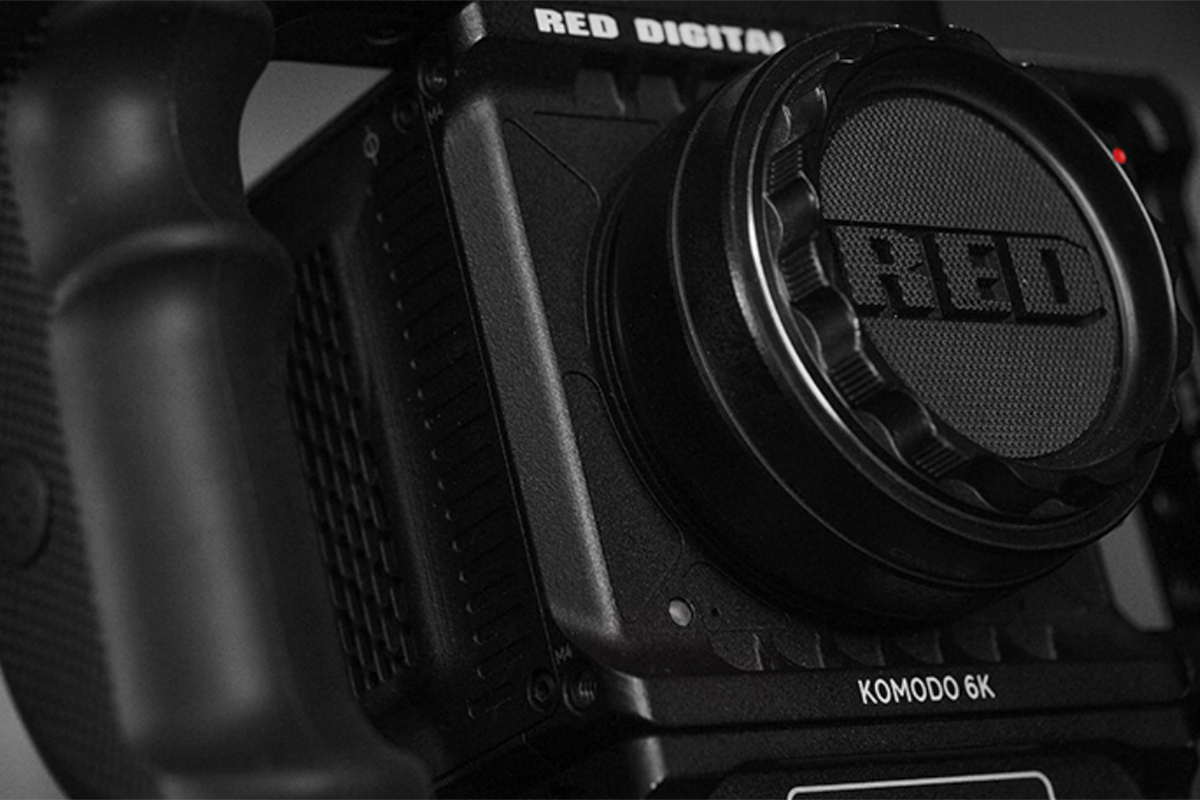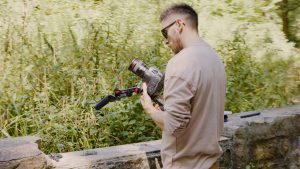Should you lock your camera down or carry it throughout your shoot? Let’s look at when to use each setup.
It’s an age-old question: which camera setup is best for me? While every videographer has their specific tastes and wants when it comes to their camera, these don’t always align with what they need. While the RED logo is still something that carries a lot of clout, for example, it doesn’t necessarily mean it is the end all be all to your growth as a filmmaker. There are smaller, more economically friendly options that will get you to the finish line and secure repeat clients.
Let’s discuss.
What Type of Work Are You Doing?
Every videography/cinematography job is different. Weddings are vastly different from corporate events, and corporate events are vastly different from commercials. Each job presents unique challenges that inevitably end up being very specific hurdles you need to jump over in different ways.
In my experience, run-and-gun shoots are usually not surprises — you know in advance that the event requires you to follow subjects around or to just get general coverage. In both circumstances, you’ll be on the move. In the same vein, interview shoots are also something you’ve planned ahead of time. So given these unique challenges, which camera is best for each situation? First, let’s discuss run-and-gun situations.
Run-and-Gun Cameras
Sony FX3 and Sony FX6
These two camera bodies are going to be your best bet for ensuring success in three important categories: autofocus, stabilization, and image quality. The Sony colors have “apparently” been improved upon (even though they were just fine before), and the autofocus is probably the best in game right now. In my opinion, they’re designed for run-and-gun, documentary-esque situations that require little setup and breakdown.
The Sony FX3 might be the safest bet for you. Its lightweight, incredibly well built, and fun to shoot with (this is an underrated quality in a camera).
The FX6 can capture DCI 4K, while the FX3 is limited to UHD 4K — this is one of many reasons there’s an almost-$2,000 USD price difference between the two.
The FX3 might be the better option for auto-focus due to its touch screen interface. Aside from that, its autofocus capabilities are more than stellar. In fact, it’s the best you’re going to find on the market. This is why it’s the perfect run-and-gun, solo-shooter’s dream.
The FX6 has internal, electronic NDs filters built in, with a feature that automatically sets the ND. So, for example, if you’re shooting your subjects outside, and they walk inside, the camera’s internal ND filter automatically reduces in strength to correct the exposure now that you’re indoors. This is yet another reason the FX6 is a run-and-gun shooter’s dream. The only hesitation you might have is the price point.
But, like I said before, you really can’t put a price on ergonomics, and when it comes to run-and-gun. You want something simple, small, and effective. On the flip side, the FX6 has that bigger, cinema camera body build that will look more attractive on set, allowing you to potentially charge more, and well . . . to look more legit.
The only decision you really need to make is if you want to fork over the cash for the FX6 if you’re in the business of investing in your company or these types of gigs — or if you just need a super light, super quick, solid B-cam that can also serve as your A-cam.
So let’s move on to another manufacturer that’s listening to its customers by releasing a monster of a camera.
Fujifilm XH2S
One of the newer options available, the Fujifilm mirrorless XH2S is the improved version of the Fujifilm H2 that was released a few years ago. Fujifilm has posited this as a “video-centric” camera with photography capabilities. So one of the biggest reasons I’ve included it in this list is the ability to quickly go from video to photo.
Just recently, I was shooting a video in a big warehouse with a lot of machinery, and the client asked if I could take a few photos. While this is usually frowned upon (since you were hired to shoot video, so video is what you prepared for), this type of request is inevitable, and if you imagine having a setup like the Fujifilm XH2S, who is saying you couldn’t just say “yes,” take the photo, and then charge more at the end of the project? This camera is perfect for these spontaneous requests.
The camera acts as a hybrid between still and video — sort of a cross between the Fujifilm XT4 and the Fuji GFX 50sii. It’s a marvelous little camera that is only going to get more popular in the coming months and years. The XH2S has incredible stabilization, and it offers that lightweight setup that makes handheld shooting possible.
On top of this, you’ll be introduced to the world of Fuji’s lenses, which I can personally say is some of the best glass on the market. I highly recommend the XF 16-55mm f/2.8 for wide, run-and-gun-friendly shoots that will get you the coverage you need.
Shooting Interviews
When looking at cameras that fit the criteria for interview setups, there are a few details to focus on. First, how many cameras do you regularly need for interviews? Is this a one-camera setup type of client, or would you prefer to always have a reliable A and B cam situation for interviewing?
With interviews, you don’t need the bells and whistles of run-and-gun shoots — you just need solid image quality that you’re comfortable shooting with. Here are the cameras I recommend checking out for their outstanding image quality and minimal cinematic approach that will get you the best-looking footage for your buck.
Blackmagic Pocket Cinema Camera 6K/URSA Lineup
On the flip side of the run-and-gun approach, interviews don’t need exceptional autofocus or in-body stabilization because the shots are usually locked off on tripods with your subjects either sitting or standing in one position for the duration of the interview. These types of shoots lend themselves more to traditional cinema cameras and rigs. Every aspect of the shooting environment is under your control. The lighting is set to your liking, focus is locked off, and there’s really no other unexpected requirements that might pop up, leading you to pick up the camera.
I’ve shot countless interviews with the Blackmagic Pocket Cinema Camera 6K and have never been let down by the ease with which the camera operates — from its user interface to the size and speed of the camera. While this is definitely not a run-and-fun friendly camera, when thrown to 60 frames per second, you can go handheld and get stellar footage. That being said, I still think it performs best when mounted on a tripod.
The BMPCC6K does have auto focus that works just fine for interview situations when there’s virtually no movement. So it’s kind of a win-win for shooters.
When it comes to stabilization, there’s virtually none to be found internally with BMD, so you’ll absolutely need a gimbal or easy rig if you need to pick up the camera to get moving coverage of your subject when shooting at 24 fps. The camera shake is real when not using a gimbal. Overall, Blackmagic Design makes incredible cameras that will not only produce beautiful images but will also work with you rather than against you during productions. Blackmagic has yet to let me down on interview shoots.
RED Komodo
Perhaps the most popular camera to be released in the past three years, the RED Komodo is a monster cinema camera that brings the 19.9 MP Super 35mm Global Shutter CMOS with 16 stops of dynamic range — so you’re going to get an incredible image with a reputable brand that will look professional on sets. What more is there to say about RED cameras other than you get what you pay for, generally speaking.
The Komodo has adequate auto-focus and is already more inclusive to shooters that aren’t currently already in the RED-iverse, through its ditching of proprietary tech. So, for that, I wholeheartedly recommend the Komodo for anybody needing a stellar A-cam for interviews and documentaries.
If you’re looking for stabilization help in the form of a gimbal that works with the Komodo, check out the Zhiyun Crane 2S and the DJI RS 3 Pro. The Komodo has an RF lens mount but comes with an EF adapter so if you’re shooting with Canon or Blackmagic Design, your lenses will work here, allowing you to save a bit more money on the new camera purchase.
So, personally, I set out to write this article because I need a second camera, and I wanted to do the research to determine my best bet. Since the gigs I’ve been getting consist of both interviews and run-and-gun coverage, do I need both? I already own a BMPCC6K, so for now I think it makes the most sense to snag the Fujifilm X2HS as the second camera that can also serve as a stills body for whenever I book photo gigs. The fact that there is BRAW capability with the Fuji changes everything, and it just makes the most economical sense as well.
Does the gig lend itself to more run-and-gun situations that might require a light rig with stabilization and autofocus? Maybe it’s time to go small and snag that Sony FX3 everyone is raving about. Do you want more of a rig that’s built out and professional looking? Maybe you should go with a RED Komodo. The choice is yours.
Looking for some music for your projects? At Videvo, our library has everything from free ambient music to music for streams — perfect for any indie project:
- Royalty-free Christmas music
- Royalty-free meditation music
- Royalty-free upbeat music
- Royalty-free jazz music
- Royalty-free Halloween music
Need a break? Check out our videvoscapes — the ultimate reels for relaxation or concentration. Each videvoscape collects hours of high-definition nature footage and background video with downtempo chill beats for the ultimate escape from the grind.




